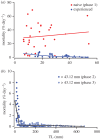Body size and mortality rates in coral reef fishes: a three-phase relationship
- PMID: 27798308
- PMCID: PMC5095387
- DOI: 10.1098/rspb.2016.1858
Body size and mortality rates in coral reef fishes: a three-phase relationship
Abstract
Body size is closely linked to mortality rates in many animals, although the overarching patterns in this relationship have rarely been considered for multiple species. A meta-analysis of published size-specific mortality rates for coral reef fishes revealed an exponential decline in mortality rate with increasing body size, however, within this broad relationship there are three distinct phases. Phase one is characterized by naive fishes recruiting to reefs, which suffer extremely high mortality rates. In this well-studied phase, fishes must learn quickly to survive the many predation risks. After just a few days, the surviving fishes enter phase two, in which small increases in body size result in pronounced increases in lifespan (estimated 11 d mm-1). Remarkably, approximately 50% of reef fish individuals remain in phase two throughout their lives. Once fishes reach a size threshold of about 43 mm total length (TL) they enter phase three, where mortality rates are relatively low and the pressure to grow is presumably, significantly reduced. These phases provide a clearer understanding of the impact of body size on mortality rates in coral reef fishes and begin to reveal critical insights into the energetic and trophic dynamics of coral reefs.
Keywords: body size; cryptobenthic reef fish; growth; mortality; predation; recruitment.
© 2016 The Author(s).
Figures


References
-
- Damuth J. 1981. Population density and body size in mammals. Nature 290, 699–700. (10.1038/290699a0) - DOI
Publication types
MeSH terms
Associated data
LinkOut - more resources
Full Text Sources
Other Literature Sources

